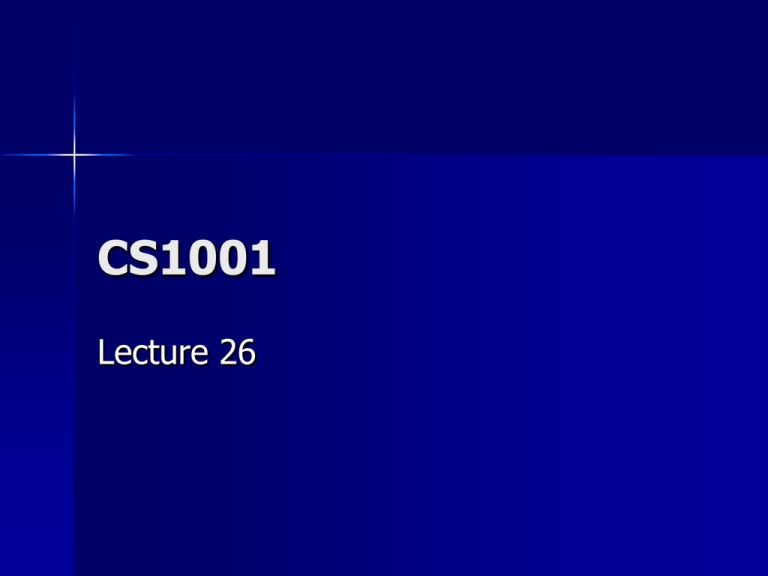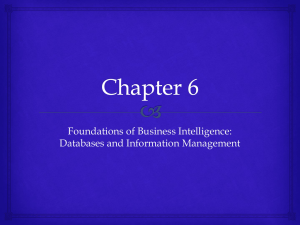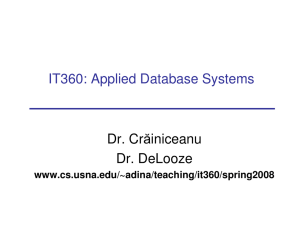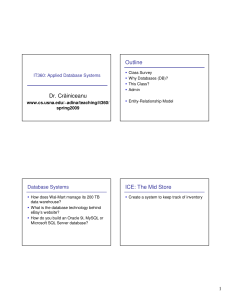CS1001 Lecture 26
advertisement

CS1001 Lecture 26 Overview Artificial Intelligence Database Systems Reading Brookshear, 9 Databases Databases hold knowledge One fundamental limitations of all computation is having knowledge represented in an available and structured way (needed for AI) http://www.abenteuermedien.de/jabberwock/ File-Oriented System Database-Oriented System Definition A database is a collection of related data example: – 1. collection of names, home address and telephone numbers – 2. collection of words to make paragraph in a page A database represents some aspect of the real world, sometimes called the miniworld or the Universe of Discourse (UoD). A database is a logically coherent collection of data with some inherent meaning. A random assortment of data cannot correctly be referred to as a database. Definition …. A database is designed, built, and populated with data for a specific purpose. It has an intended group of users and some preconceived applications in which these users are interested. A database can be of any size and of varying complexity A database may be generated and maintained manually or it may be computerized (set of application programs or by RDBM). Database Management System Is a collection of programs that enables users to create and maintain a database. The DBMS is a general-purpose software system that facilitates the processes of defining, constructing, and manipulating databases for various applications Defining: a database involves specifying the data types, structures, and constraints for the data to be stored in the database. DBMS ….. Constructing: the database is the process of storing the data itself on some storage medium that is controlled by the DBMS. Manipulating: a database includes such functions as querying the database to retrieve specific data, updating the database to reflect changes in the miniworld, and generating reports from the data. We will call the database and DBMS software together a database system Example UNIVERSITY database for maintaining information concerning students, courses, and grades in a university environment define: file (records), data elements, data type ( for each data element) construct: store data in the appropriate files (note that records may be related between files) Manipulation: querying, updating – informal queries and updates must be specified precisely in the database system language before they can be processed. DB Vs Programming with files Self-Describing Nature of a Database System – single repository of data is maintained – contains not only the database itself but also a complete definition or description of the database structure and constraints (system catalogue). – information stored in the catalog is called meta-data – catalog used by the DBMS and users. – The DBMS software work equally well with any number of database applications. DB Vs Programming with files ….. Insulation between Programs and Data, and Data Abstraction – program-data independence – The characteristic that allows program-data independence and program-operation independence is called data abstraction – A DBMS provides users with a conceptual representation of data that does not include many of the details of how the data is stored or how the operations are implemented. (data model ) – data model hides storage and implementation details that are not of interest to most database users. – in object-oriented and object-relational databases, abstraction is carried one level further to include not only the data structure but also the operations on the data Database Actors Database Administrators – In a database environment, the primary resource is the database itself and the secondary resource is the DBMS and related software – authorizing access to the database – coordinating and monitoring its use – acquiring software and hardware resources as needed Database Designers – identifying the data to be stored in the database – choosing appropriate structures to represent and store this data undertaken before the database is actually implemented and populated with data Database Actors ….. – communicate with all prospective database users, in order to understand their requirements – develop a view of the database that meets the data and processing requirements for each group of users – These views are then analyzed and integrated with the views of other user groups. The final database design must be capable of supporting the requirements of all user groups End Users – access to the database for querying, updating, and generating reports – Casual end users: – occasionally access the database – need different information each time – learn only a few facilities that they may use repeatedly. Database Actors ….. – use a sophisticated database query language to specify their requests – typically middle- or high-level managers or other occasional browsers Naive or parametric end users – constantly querying and updating the database, using standard types of queries and updates called canned transactions that have been carefully programmed and tested – need to learn very little about the facilities provided by the DBMS – Bank tellers check account balances and post withdrawals and deposits – Reservation clerks for airlines, hotels, and car rental companies check availability for a given request and make reservations – Clerks at receiving stations for courier mail enter package identifications via bar codes and descriptive information through buttons to update a central database of received and in-transit packages Database Actors ….. Sophisticated end users – Engineers, scientists, business analysts, and others who thoroughly familiarize themselves with the facilities of the DBMS so as to implement their applications to meet their complex requirements – Try to learn most of the DBMS facilities in order to achieve their complex requirements Stand-alone users – Maintain personal databases by using ready-made program packages that provide easy-to-use menu- or graphics-based interfaces. An example is the user of a tax package that stores a variety of personal financial data for tax purposes – Typically become very proficient in using a specific software package Database Actors ….. System Analysts and Application Programmers – Determine the requirements of end users, especially naive and parametric end users, and develop specifications for canned transactions that meet these requirements – Application programmers implement these specifications as programs; then they test, debug, document, and maintain these canned transactions Workers behind the Scene – Typically do not use the database for their own purposes – DBMS system designers and implementers – design and implement the DBMS modules (for implementing the catalog, query language, interface processors, data access, concurrency control, recovery, and security. ) and interfaces as a software package Database Actors ….. Tool developers – Tools are optional packages that are often purchased separately – include packages for database design, performance monitoring, natural language or graphical interfaces, prototyping, simulation, and test data generation. Operators and maintenance personnel – system administration personnel who are responsible for the actual running and maintenance of the hardware and software environment for the database system The conceptual layers of a database Asking Questions The Database is an oracle – you need to be able to pose it questions and receive answers For relational databases, the language of choice is SQL (Structured Query Language) Questions The goal is to allow unambiguous questions to be formulated and for the system to encode information in such a way as to provide unambiguous answers You must model your problem to properly represent its information Example: Employee Records Example Data Key Point is how to structure this as to reduce redundancy Eliminating Redundancy (replacing it with relations) allows for unambiguous question answering Note that this is a table (fundamental structure of a database) Solution The solution is to decompose a single database table into multiple tables and set up relationships between the tables Files Note that each table is similar in structure to a flat file The added value of a database makes it easy to search among relationships between such flat files




